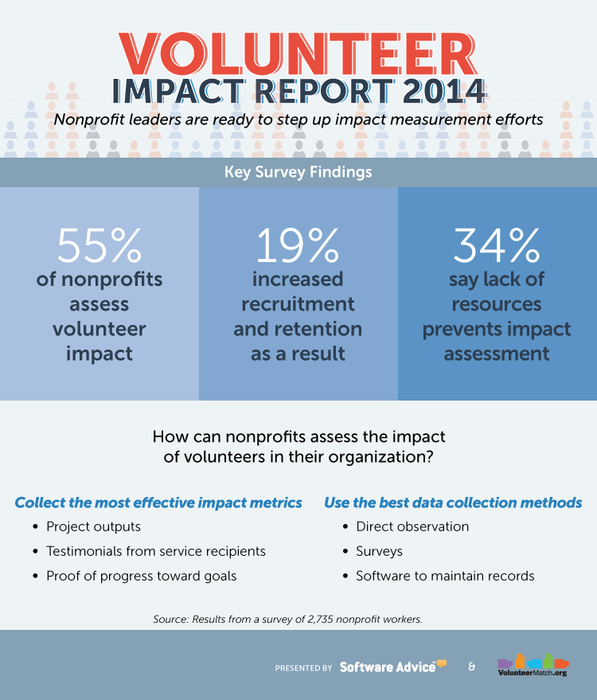Too often non-profit organizations spend an inordinate amount of their time and effort focused solely on soliciting and tracking hard dollars and cents. And of course this makes perfect sense, as a strong and steady revenue stream is the lifeblood of many groups, allowing them to further their cause and achieve their goals.
But a crucial element of a non-profit’s structure—and one that is sometimes overlooked in the chase for charitable donations—is the positive impact volunteers can and are having within an organization. Indeed, a recent survey of nearly 3,000 nonprofit professionals by Software Advice, who partnered with Volunteer Match, uncovered some surprising statistics: 70 percent of responding organizations believe that collecting volunteer data is valuable to the quality, scope and outcome of their programs, yet 63 percent of organizations that don’t measure volunteer impact cite lack of resources and knowledge as their reason for failing to do so.
The report delved into critical details that any non-profit utilizing a volunteer base should be aware of, including demographic information and, most importantly, why many non-profits just aren’t measuring volunteer impact. Indeed, of the 45 percent of respondents who reported that their organizations don’t measure volunteer impact, 34 percent attributed the failure to a lack of resources and tools, 29 percent said that a lack of skills or knowledge prevented measurement and 25 percent said their organization’s staff lacks the time.
Of course, all this data begs an obvious question: why aren’t more non-profits measuring volunteer impact? The answers vary, although the report cites that six percent of respondents simply don’t believe the data was important, as their organization doesn’t engage enough volunteers to make the data valuable, or the non-profit’s leadership already understands the impact their volunteers make.
However, the report does note that a majority of respondents whose organizations measure volunteer impact say the data is useful, “giving leaders insights that inform decisions to improve the quality, reach and outcomes of volunteer programs and to increase funding.” And what are the outwardly obvious benefits of measuring and charting volunteer impact? It appears that at least a fifth of responding organizations used the data to adjust their volunteer programs themselves, resulting in a higher recruitment level and boosting the retention rates of existing volunteers. Hence gathering the data can certainly lead to a self-fulfilling prophecy: study your volunteer base’s impact on your non-profit, and use that information to garner more volunteers.
In the end, it would seem that the real value of gauging and assessing the impact of a volunteer base does indeed revolve back to the question of capital fundraising. According to Custom Development Solutions, Inc. “recent studies estimate that about a hundred million people volunteer each year with an annual value in the range of $150 billion. Not only do volunteers help to save money, they can provide better service to clients, increase contact with the greater community, make available better expertise and reduce costs of services.
And so, it would seem, keeping tabs on the effects your volunteer base is having to your organization can and will translate back to hard dollars and cents.



